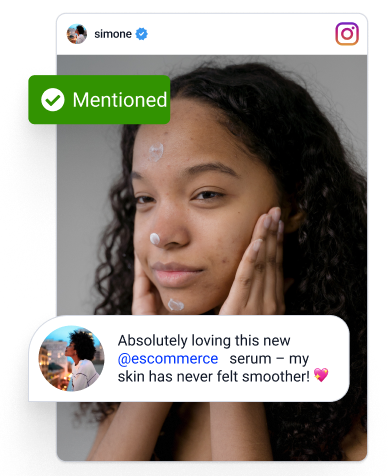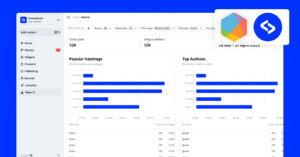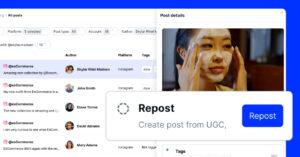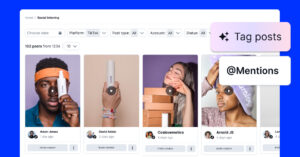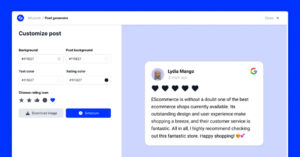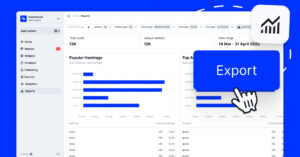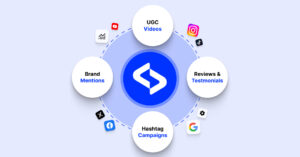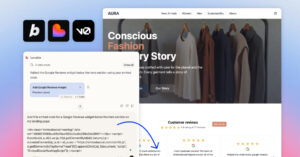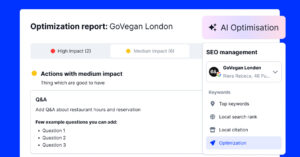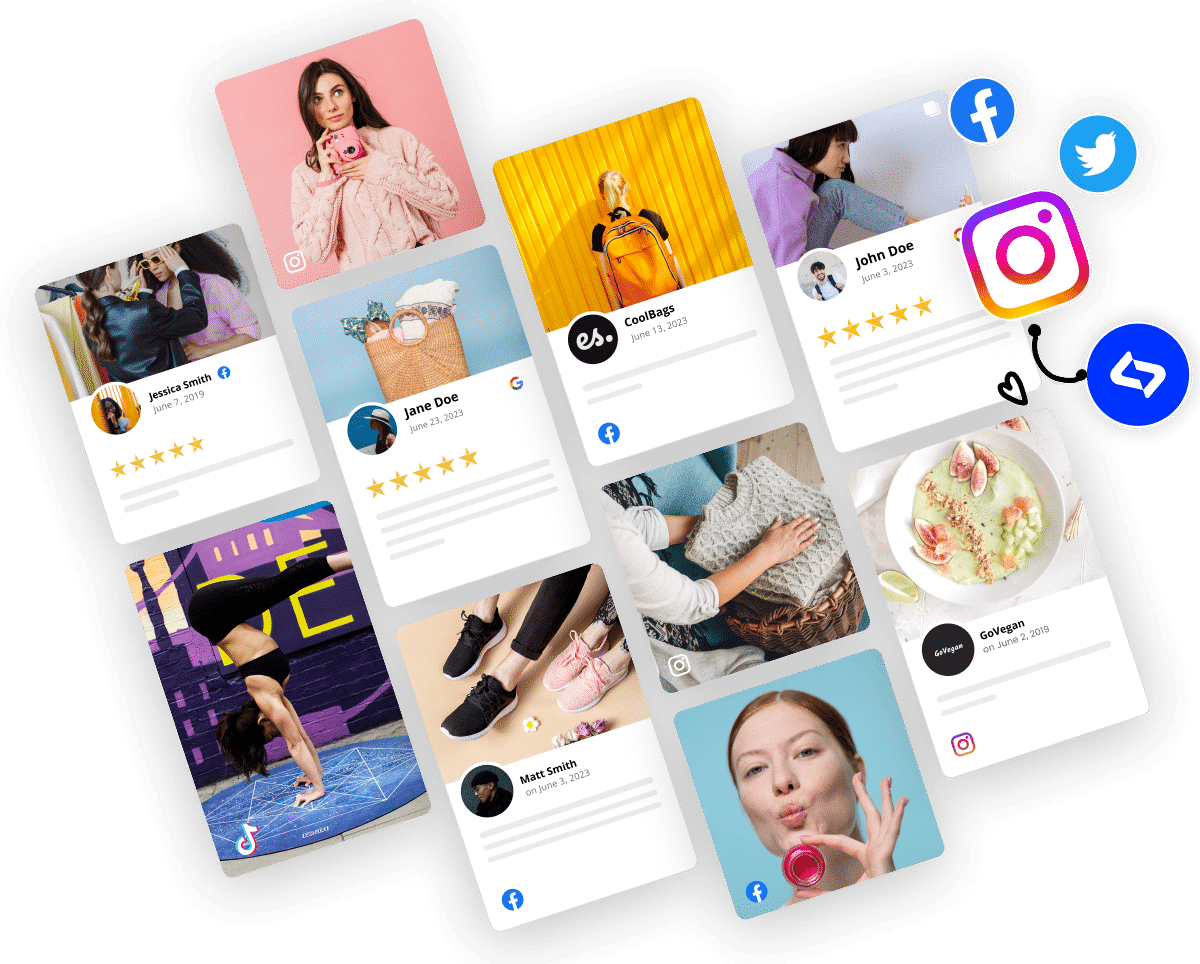Está a fazer negócios com outras marcas ou empresas? Então, precisa definitivamente de empregar uma estratégia sólida de escuta social B2B para obter as informações de que necessita.
Há muito a aprender com as plataformas sociais, fóruns e comunidades de nicho para o ajudar a manter-se um passo à frente da sua concorrência. Desde o acompanhamento da perceção da marca até à deteção de feedback sobre o produto, todos os pequenos detalhes que recolher podem dar-lhe a vantagem de que necessita.
No entanto, é necessário ter uma estratégia bem direcionada e o ferramentas de escuta social para obter uma compreensão clara do seu público e das conversas específicas do sector.
Por isso, vou mostrar-lhe exatamente como abordar o B2B monitorização social da EmbedSocial da forma correta e dar-lhe 7 melhores práticas para o ajudar a obter resultados reais.
O que é a escuta social para as marcas B2B?
A escuta social B2B é o processo de rastreio e análise de conversas em canais digitais que sejam relevantes para a sua marca, sector, concorrentes ou clientes.
Dito isto, vai muito além da simples monitorização das menções. A verdadeira escuta social ajuda-o a compreender ajuda as pessoas estão a falar, o que que lhes interessapor como esses conhecimentos pode alimentar decisões mais inteligentes em marketing, vendas, produtos e até no sucesso do cliente.
Está à procura de dados enterrados em fóruns de nicho, comentários do LinkedIn, tópicos do Reddit, etc., que revelam o que os compradores, parceiros e até concorrentes estão realmente a pensar.
Quando bem feita, a escuta social B2B gera uma visão clara do mercado para que possa agir mais rapidamente, elaborar mensagens melhores e atuar com mais confiança.
Em que é que difere da escuta social B2C?
Ao contrário da escuta social B2C, que se concentra em conversas de grande volume e viradas para o público, a escuta social B2B encontra conversas especializadas que influenciam decisões de compra complexas.
Porque é que as marcas B2B precisam mais do que nunca de ouvir as redes sociais?
A pesquisa de escuta social B2B é essencial para se manter relevante e competitivo:

- Os ciclos de vendas B2B mais longos envolvem mais decisores, o que torna crucial compreender as preocupações de todas as partes interessadas nos diferentes canais;
- Conversas de baixo volume mas de grande impacto ocorrem frequentemente no LinkedIn, no Reddit ou em fóruns de nicho, onde uma informação pode mudar a sua estratégia;
- Reputação e sinais de confiança mais fortes são construídas quando se responde ao feedback, se participa em discussões relevantes e se aparece com autenticidade;
- Informações sobre a concorrência em tempo real revelar como os outros estão a posicionar as suas soluções, o que está a funcionar para eles e onde se pode diferenciar;
- Feedback de produtos não filtrado ajuda-o a dar prioridade às actualizações e a apresentar o que o seu mercado realmente pretende nas suas campanhas de marketing nas redes sociais;
- Alinhamento entre vendas e marketing torna-se mais fácil quando todos trabalham a partir da mesma transmissão em direto do sentimento dos clientes e das tendências do sector;
- Ideias de conteúdos orientados para o cliente resultam diretamente de ouvir os pontos fracos, as perguntas e as tendências emergentes do seu público.
Quanto mais sintonizado estiver, mais rapidamente poderá atuar com confiança e clareza.
Como fazer pesquisa de escuta social B2B com EmbedSocial em 5 passos simples?
Mais do que uma norma redes sociaisA EmbedSocial está equipada para satisfazer as necessidades de empresas de todas as dimensões e feitios. Tudo o que é preciso são alguns passos para fazer a ponte entre a análise de sentimentos e as estratégias de marketing acionáveis:
1. Definir o tipo de mensagens e palavras-chave a seguir para a sua empresa
Em primeiro lugar, é necessário efetuar uma pesquisa de palavras-chave adequada ao seu tipo de negócio. Temos uma Gerador de palavras-chave de escuta social para esse efeito, e inclui apenas alguns passos simples:
- Abra a aplicação Google Maps descrever a sua atividade e os seus objectivos:
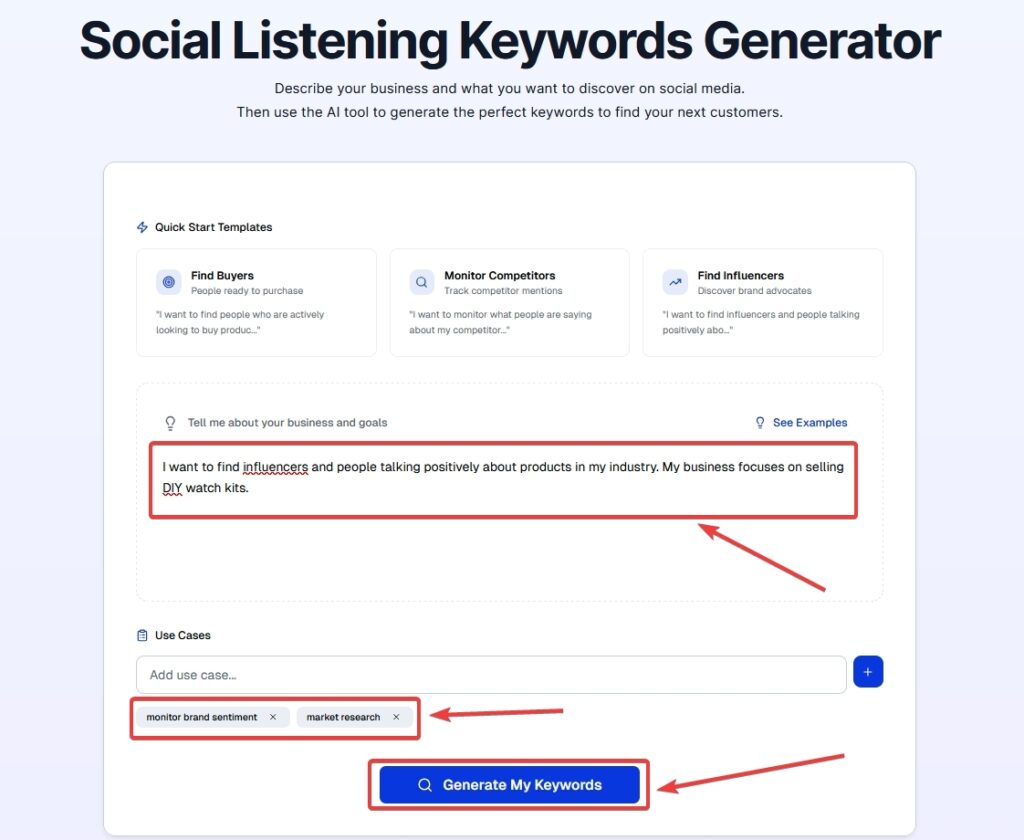
- Depois, pode afinar as palavras-chave gerados pela nossa IA:
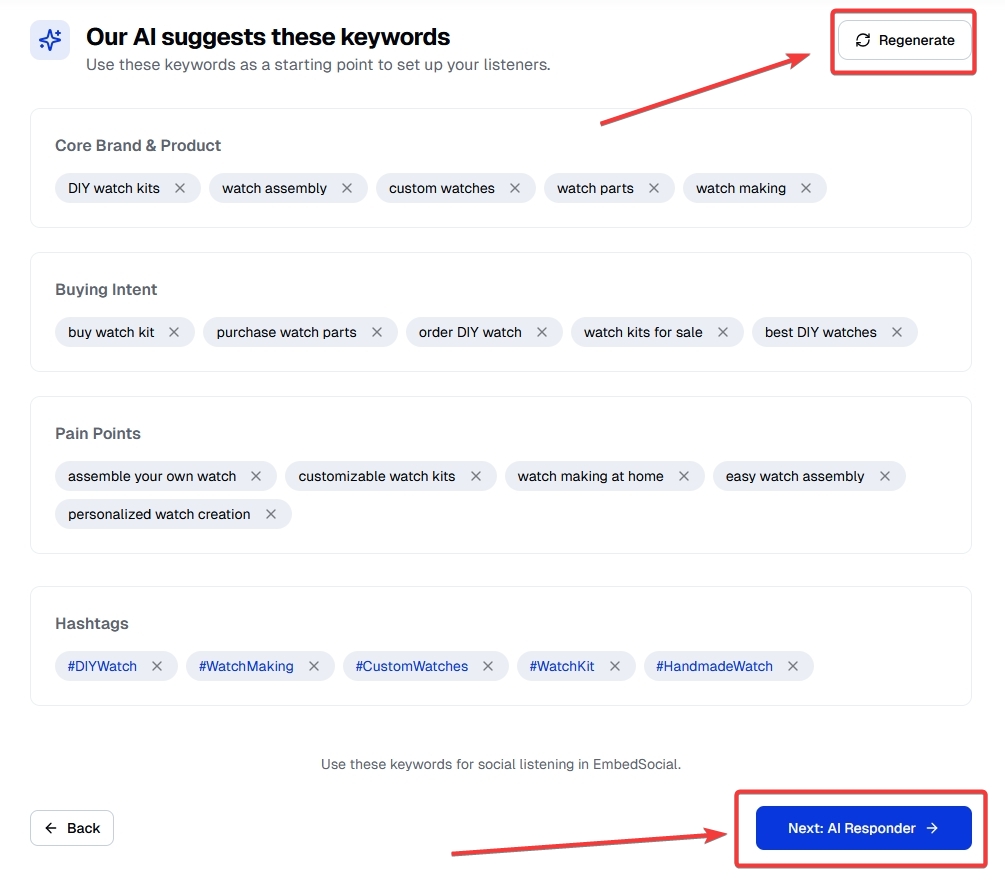
- Pode até criar respostas de IA para palavras-chave específicas:
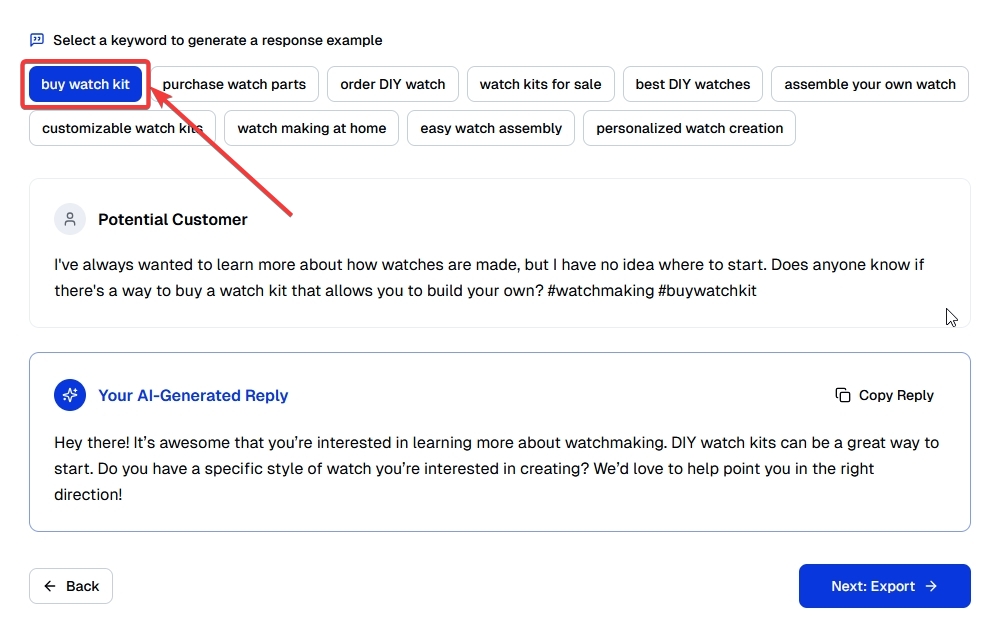
- Por fim, exportar os dados das palavras-chave ou ir diretamente para a monitorização utilizando EmbedSocial:

2. Inscreva-se no EmbedSocial e ligue as suas redes sociais
Antes de mais, inscreva-se no EmbedSocial e ligue as suas redes sociais:
- Criar a sua conta: Crie uma conta para o nível de escuta social da EmbedSocial;
- Adicione todas as suas fontes: Clique em 'Fontes' → 'Adicionar nova fonte';
- Escolha plataformas relevantes: Selecione as plataformas utilizadas pelas empresas que pretende monitorizar:
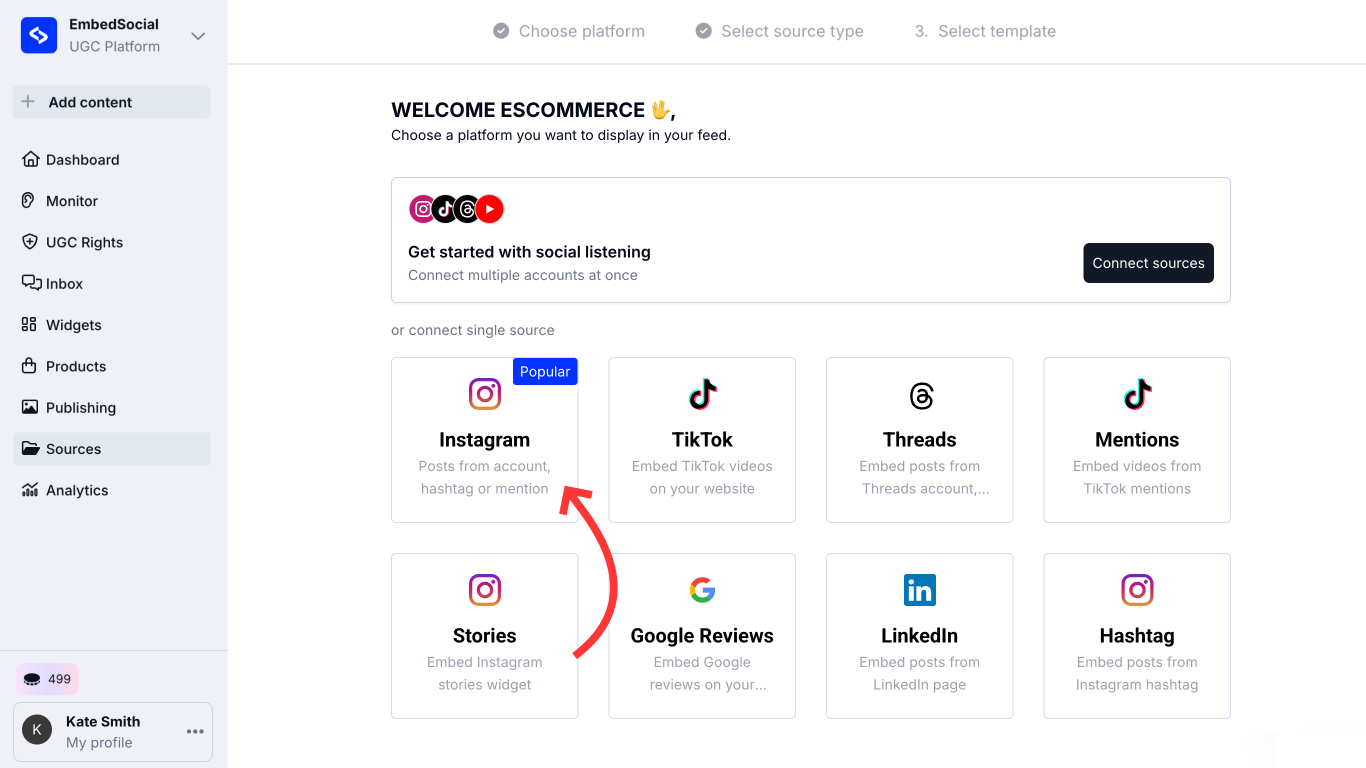
3. Configure a monitorização das suas hashtags, menções e/ou palavras-chave
Depois de escolher a sua fonte, é altura de a configurar:
- Fornecer palavras-chave ou contas: Escolha as contas que pretende seguir ou palavras-chave relacionadas, como os identificadores dos seus concorrentes ou hashtags específicas da campanha;
- Escolher mais do que uma fonte: Pode repetir o processo tantas vezes quantas as necessárias para adicionar todas as fontes que pretende monitorizar:

4. Comece a monitorizar e a organizar o seu UGC social
Dirija-se ao Separador "Monitorizar no menu da faixa de opções à esquerda para iniciar o rastreio:
- Utilize vários filtros para identificar conteúdos específicos: Pode filtrar com base na data, plataforma, tipo de conteúdo ou contas específicas;
- Organize e personalize o seu UGC recolhido: Utilize etiquetas em mensagens específicas, active/desactive/elimine-as ou edite-as se as quiser reutilizar:
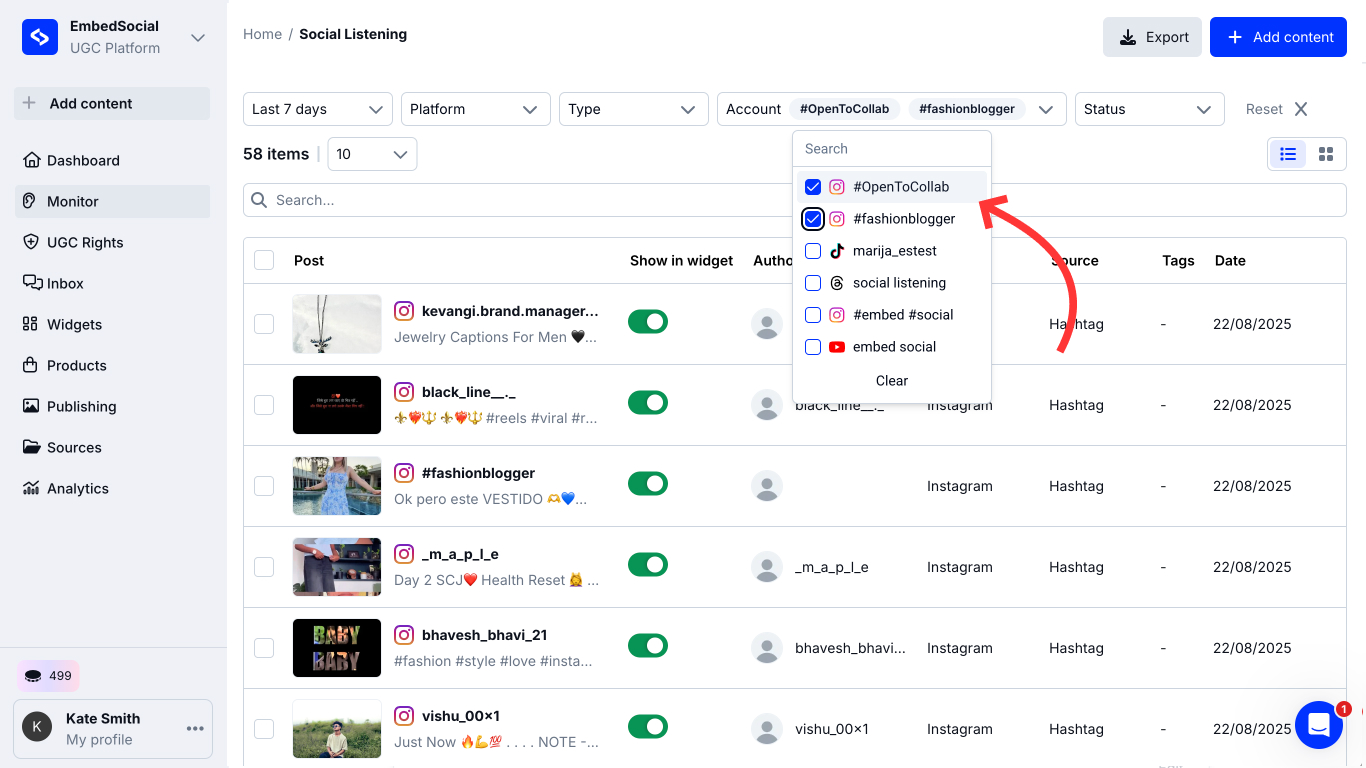
5. Descobrir e estabelecer contactos com potenciais parceiros ou clientes
Com o EmbedSocial, pode utilizar hashtags ou palavras-chave para descobrir potenciais clientes, influenciadores ou colaboradores diretamente no seu Painel de controlo da escuta social.
Quando encontrar uma publicação que pretenda utilizar, basta abrir os detalhes da publicação e clicar em "Pedir direitos". Isto permite-lhe enviar instantaneamente um DM ou comentário para o criador e solicitar autorização para reutilizar o seu conteúdo como CGU.
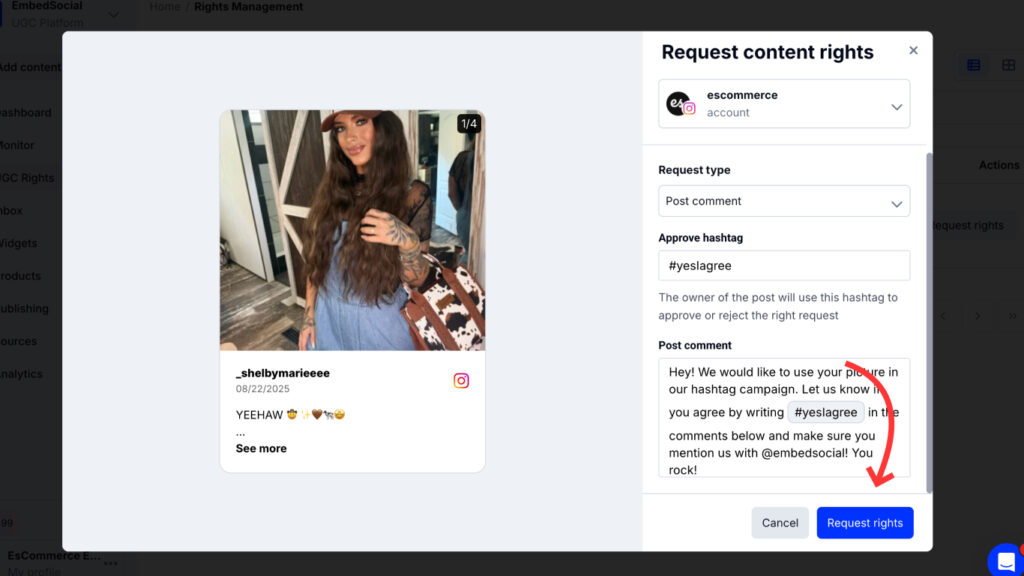
6. Analisar os dados das redes sociais para obter informações sobre a marca
Por fim, navegue para a secção Secção "Análise para obter os seus conhecimentos:
- Aceder à secção "Análise": No seu painel de instrumentos, toque em "Analítica (menu do friso esquerdo) e descarregue os seus dados com base em vários filtros;
- Analise as suas mensagens monitorizadas: Ligue esse ficheiro ao ficheiro Ferramenta "Analytics para encontrar tendências e sentimentos relacionados com a sua marca e os seus produtos:
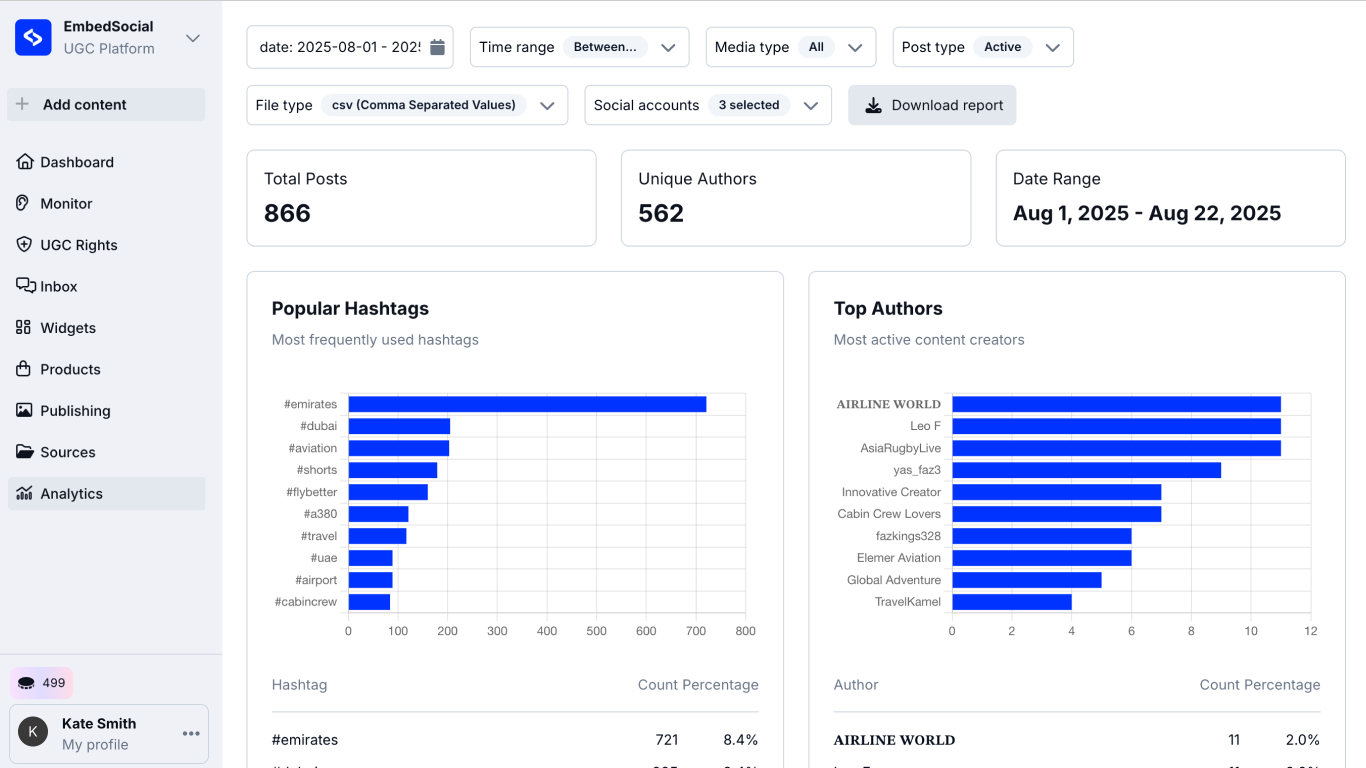
Passo de bónus: Utilizar o UGC recolhido no seu sítio Web
Obter as suas percepções não é o último passo. O EmbedSocial permite-lhe incorporar o seu UGC nos seus sítios Web em apenas alguns passos simples:
- Abrir o editor de widgets: Acesso 'Widgets' → widget de hashtag ou menções específicas;
- Crie e personalize o seu widget: Pode aceder a várias opções de edição para alterar tudo, desde o aspeto do widget até às etiquetas de produto que inclui;
- Copie o código do widget incorporável: Prima "Incorporar (canto superior esquerdo) → 'Copiar código';
- Cole o código no seu sítio Web: Abra o editor do seu sítio Web, navegue para a página que pretende editar, coloque um contentor HTML vazio e cole o código.
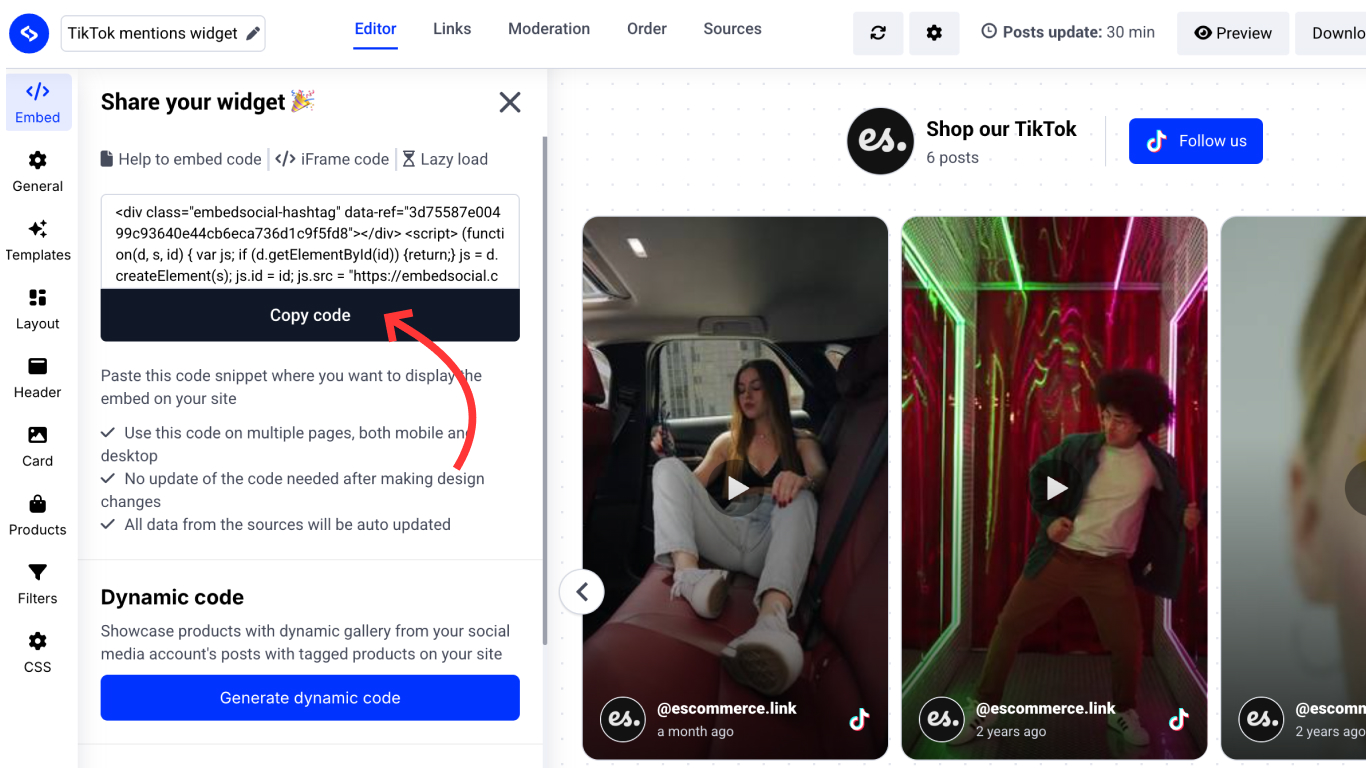
Porquê escolher a EmbedSocial para as suas necessidades de escuta social B2B?
Seja qual for o seu monitorização social da EmbedSocial necessidades, desde o acompanhamento com as avaliações mais recentes, para monitorizar os concorrentes da sua empresa e recolher informações para vendas e marketing, precisa da plataforma certa para o efeito. EmbedSocial é uma dessas opções:
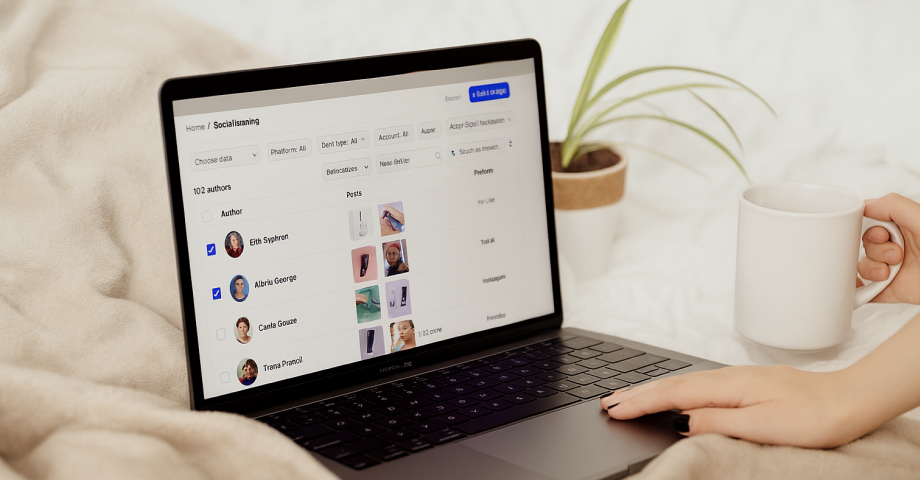
Eis como a EmbedSocial o ajuda a tirar o máximo partido da sua estratégia de escuta social B2B:
- Monitorização em tempo real de palavras-chave de marca-Acompanhe as menções e hashtags da sua empresa, produtos ou concorrentes em vários canais sociais;
- Análise de sentimentos com marcação automática-saiba como as pessoas se sentem em relação à sua marca, com informações categorizadas por emoção, tópico ou fonte;
- Agregação entre canais-puxar UGC do Instagram, TikTok, Facebook, Google, X (Twitter) e outras plataformas de redes sociais num painel de controlo centralizado;
- Etiquetagem e filtros de tópicos personalizados-Organizar as conversas sociais por departamentos, campanhas ou temas estratégicos para uma melhor colaboração;
- Repositório de feedback pesquisável-encontrar instantaneamente menções e tendências anteriores utilizando vários filtros, tais como intervalos de datas, palavras-chave, tipo de conteúdo, etc.
- Informações e resumos com base em IA-obter rapidamente informações sobre o que está a ser tendência e porquê, sem ter de analisar manualmente milhares de comentários;
- Relatórios e alertas partilháveis-exportar informações ou programar automaticamente alertas de equipa para que todos se mantenham alinhados em tempo real.
Conclusão: se procura clareza sem complexidade (ou preços exorbitantes), é tão fácil como inscrever-se no EmbedSocial em alguns passos rápidos e começando a monitorizar.
Exemplos reais de escuta social B2B em ação
Está à procura de alguns exemplos reais de escuta social B2B? Aqui estão três deles que mostram como as empresas estão a obter um valor comercial real da escuta estratégica:
1. S&P Global Commodity Insights - Racionalização dos conhecimentos
Desafio:
A equipa de marketing da S&P Global estava a gastar demasiado tempo na recolha manual de dados e na elaboração de relatórios, o que atrasava as decisões estratégicas.
Ação:
Estabeleceram uma parceria com o Ten Bear Group para automatizar os seus fluxos de trabalho de escuta social e a estrutura de relatórios.
Resultado:
Liberta de tarefas repetitivas, a equipa redireccionou a sua energia para uma análise mais profunda e para acções comerciais mais rápidas e orientadas para o conhecimento.
💡 Com o EmbedSocial, pode descarregar relatórios detalhados de escuta social em vários formatos para os partilhar facilmente com todas as partes interessadas.
2. Nissan Datsun Índia - Lançamento com uma orientação mais nítida
Desafio:
Quando a Nissan reintroduziu a marca "Datsun" na Índia, necessitava de um verdadeiro feedback dos consumidores para aperfeiçoar o seu posicionamento no mercado.
Ação:
Utilizar a funcionalidade ferramentas de escuta socialA empresa seguiu as conversas em linha para descobrir o que mais agradava aos compradores indianos.
Resultado:
Descobriram que o espaço da bagageira era um ponto forte e, por isso, reforçaram-no no seu marketing e obtiveram um sentimento mais positivo.
💡 O EmbedSocial ajuda-o a detetar frases repetidas e palavras-chave emocionais nas menções dos clientes para que possa afinar as suas mensagens.
3. StrataScratch - Alinhar os preços pelas preocupações dos utilizadores reais
Desafio:
A StrataScratch estava a receber feedback de utilizadores que sentiam que os seus preços eram demasiado elevados ou pouco claros, afectando potencialmente a conversão e a retenção.
Ação:
Prestaram muita atenção ao feedback dos utilizadores partilhado nos canais das redes sociais e às avaliações públicas e, em seguida, reavaliaram os seus níveis de preços com base nessas informações.
Resultado:
Depois de ajustarem a sua estratégia de preços, registaram uma redução da rotatividade e um aumento da satisfação dos clientes.
💡 Com o EmbedSocial, pode centralizar os comentários nas redes sociais e o feedback baseado em avaliações para detetar preocupações recorrentes com os preços e dar prioridade às melhorias.
7 melhores práticas para ouvir as redes sociais B2B
Para obter resultados significativos dos seus esforços de escuta social B2B, necessita de uma estratégia de redes sociais orientada e da capacidade de medir o que é importante. Veja como fazer isso corretamente:
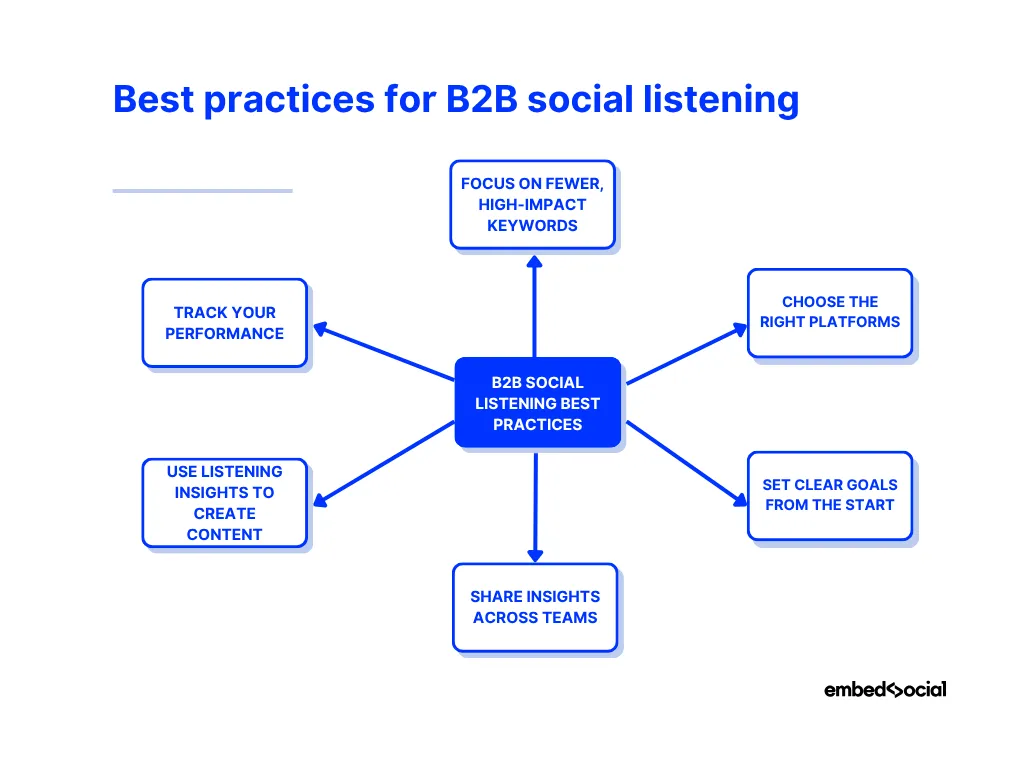
Concentre-se em menos palavras-chave de grande impacto
Em vez de seguir todas as menções à sua marca, sector ou concorrentes, concentre-se numa lista selecionada de palavras-chave que realmente se destacam. Estas podem incluir frases de cauda longa que os seus compradores utilizam, pontos problemáticos que mencionam frequentemente ou diferenciadores-chave do seu produto. Isto garante que o seu os conhecimentos são relevantes, acionáveis e não se perdem no ruído.
Escolher as plataformas certas
As conversas relevantes para o B2B raramente acontecem no Instagram ou no TikTok. Em vez disso, as suas Os compradores estão provavelmente a falar no LinkedIn, Twitter (X), Reddit, Quora, fóruns do sector e sítios de avaliação de SaaS. Certifique-se de que as suas ferramentas de monitorização das redes sociais oferecem estas plataformas e ajuste os seus esforços com base nos locais onde o seu público passa realmente tempo a discutir as suas necessidades comerciais.
Definir objectivos claros desde o início
Antes de lançar qualquer iniciativa de auscultação, defina o que pretende alcançar com as ferramentas de monitorização dos meios de comunicação social: análise da concorrência, feedback dos clientes ou geração de leads. Objectivos claros ajudam a definir o que se pretende ouvir, quais as equipas envolvidas e como será medido o sucesso mais tarde. Sem esta etapa, é fácil recolher dados mas não atuar sobre eles.
Partilhar informações valiosas entre equipas
A escuta social não é apenas para o marketing. Quando as informações são partilhadas com as equipas de produtos, vendas e sucesso do cliente, toda a empresa beneficia. Por exemplo, as vendas podem utilizar objecções em tempo real de potenciais clientes para aperfeiçoar as mensagens e as equipas de produtos podem dar prioridade às funcionalidades com base nos pontos problemáticos dos utilizadores detectados no terreno.
Utilizar as informações dos ouvintes para criar conteúdos
Um dos benefícios mais negligenciados da escuta social é a inspiração de conteúdos. Uma única discussão no Reddit ou uma publicação no LinkedIn pode alimentar tópicos de blogues, ideias para webinars, actualizações de FAQ ou mesmo páginas de produtos. É garante que está a falar a língua do seu cliente e responder a perguntas reais que estão na ordem do dia.
Acompanhe o seu desempenho com os KPIs certos
Para medir o impacto, acompanhar as métricas como quota-parte de voz (em comparação com os concorrentes), mudanças no sentimento ao longo do tempo, volume e tipo de menções, taxa de envolvimento e número de contactos qualificados gerados. Também pode monitorizar a velocidade e a qualidade das respostas da sua equipa a conversas importantes.
Estratégia de bónus: Rever e aperfeiçoar regularmente
A escuta social não é um esforço único. Definir uma cadência regularmensal ou trimestralmente - para avaliar as palavras-chave que segue, as plataformas que monitoriza e as informações a que dá prioridade. À medida que o seu público, sector ou produto evolui, o mesmo deve acontecer com a sua estratégia de escuta para manter os seus esforços nítidos e eficazes.
Conclusão: Ouvir com atenção, agir mais depressa!
Quando se utilizam as ferramentas de escuta social corretas, a escuta social B2B é uma vantagem, uma vez que lhe dá uma linha direta para as conversas nas redes sociais que moldam o seu mercado, ajudando-o a manter-se informado, recetivo e alinhado com o que o seu público-alvo realmente pretende.
Para as equipas B2B, mesmo as pequenas acções, como seguir as menções da concorrência nas redes sociais, analisar os comentários no LinkedIn ou detetar um problema recorrente no produto, podem conduzir a mensagens mais inteligentes, decisões mais rápidas e uma melhor saúde da marca.
Se estiver pronto para transformar os conhecimentos do sector em ação, experimente Ferramentas de escuta social da EmbedSocial. Terá visibilidade em tempo real, análises baseadas em IA e uma forma de partilhar as suas conclusões.
Perguntas frequentes sobre a escuta social B2B
O que é a escuta social nas empresas?
A escuta social nas empresas significa seguir e analisar as conversas em linha para compreender o que as pessoas pensam da sua marca, dos concorrentes e do sector. O objetivo final é tomar decisões mais inteligentes com base no feedback e nas tendências em tempo real.
O que significa B2B nas redes sociais?
B2B significa "business-to-business" (empresa a empresa) e, nas redes sociais, refere-se à forma como as empresas utilizam plataformas como o LinkedIn, o Facebook ou o X para se ligarem a outras empresas - não a consumidores individuais - para vendas, parcerias e visibilidade da marca.
Qual é um exemplo de escuta social num contexto B2B?
Uma empresa B2B pode seguir as publicações do LinkedIn e os tópicos do Reddit que mencionam o produto de um concorrente para encontrar os pontos fracos dos clientes e, em seguida, utilizar essa informação para melhorar as suas próprias caraterísticas ou mensagens.
Que plataforma de redes sociais é mais utilizada pelos decisores B2B?
O LinkedIn é a plataforma mais popular entre os decisores B2B, graças ao seu público profissional, às suas ricas opções de segmentação e ao facto de se concentrar em conteúdos e conversas específicos do sector.
